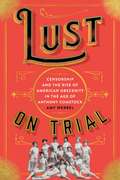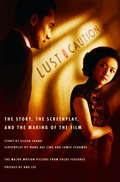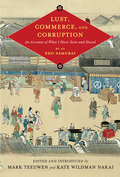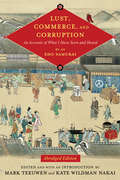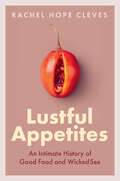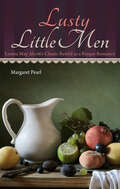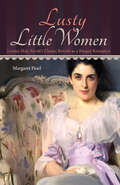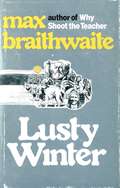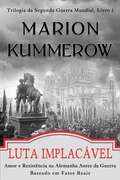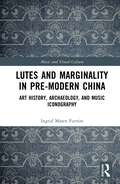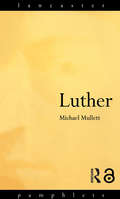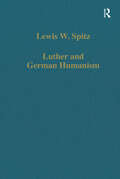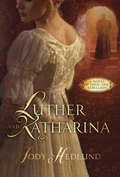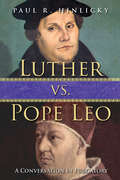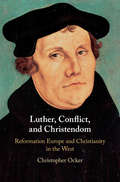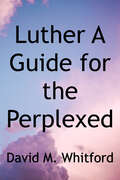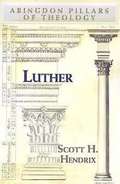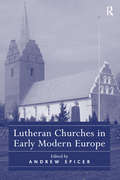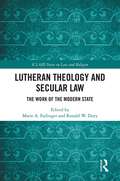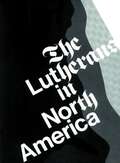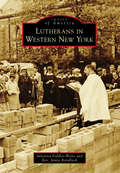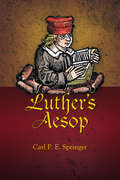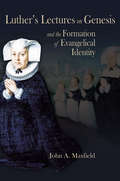- Table View
- List View
Lust on Trial: Censorship and the Rise of American Obscenity in the Age of Anthony Comstock
by Amy WerbelAnthony Comstock was America’s first professional censor. From 1873 to 1915, as Secretary of the New York Society for the Suppression of Vice, Comstock led a crusade against lasciviousness, salaciousness, and obscenity that resulted in the confiscation and incineration of more than three million pictures, postcards, and books he judged to be obscene. But as Amy Werbel shows in this rich cultural and social history, Comstock’s campaign to rid America of vice in fact led to greater acceptance of the materials he deemed objectionable, offering a revealing tale about the unintended consequences of censorship.In Lust on Trial, Werbel presents a colorful journey through Comstock’s career that doubles as a new history of post–Civil War America’s risqué visual and sexual culture. Born into a puritanical New England community, Anthony Comstock moved to New York in 1868 armed with his Christian faith and a burning desire to rid the city of vice. Werbel describes how Comstock’s raids shaped New York City and American culture through his obsession with the prevention of lust by means of censorship, and how his restrictions provided an impetus for the increased circulation and explicitness of “obscene” materials. By opposing women who preached sexual liberation and empowerment, suppressing contraceptives, and restricting artistic expression, Comstock drew the ire of civil liberties advocates, inspiring more open attitudes toward sexual and creative freedom and more sophisticated legal defenses. Drawing on material culture high and low, including numerous examples of the “obscenities” Comstock seized, Lust on Trial provides fresh insights into Comstock’s actions and motivations, the sexual habits of Americans during his era, and the complicated relationship between law and cultural change.
Lust, Caution: The Story, the Screenplay, and the Making of the Film
by Eileen Chang Wang Hui LingA major motion picture (2007) from Oscar-winning director Ang Lee (Crouching Tiger, Hidden Dragon; Brokeback Mountain): an intensely passionate story of love and espionage, set in Shanghai during World War II.In the midst of the Japanese occupation of China and Hong Kong, two lives become intertwined: Wong Chia Chi, a young student active in the resistance, and Mr. Yee, a powerful political figure who works for the Japanese occupational government. As these two move deftly between Shanghai’s tea parties and secret interrogations, they become embroiled in the complicated politics of wartime—and in a mutual attraction that may be more than what they expected. Written in lush, lavish prose, and with the tension of a political thriller, Lust, Caution brings 1940s Shanghai artfully to life even as it limns the erotic pulse of a doomed love affair.
Lust, Commerce, and Corruption: An Account of What I Have Seen and Heard, by an Edo Samurai (Translations from the Asian Classics)
by Anne Walthall Kate Wildman Nakai John Breen Trans. Eds. Teeuwen Mark Fumiko UmezawaBy 1816, Japan had recovered from the famines of the 1780s and moved beyond the political reforms of the 1790s. Despite persistent economic and social stresses, the country seemed to be approaching a new period of growth. The idea that the shogunate would not last forever was far from anyone's mind.Yet, in that year, an anonymous samurai author completed one of the most detailed critiques of Edo society known today. Writing as Buyo Inshi, "a retired gentleman of Edo," he expresses a profound despair with the state of the realm and with people's behavior and attitudes. He sees decay wherever he turns and believes the world will soon descend into war.Buyo shows a familiarity with many corners of Edo life that one might not expect in a samurai. He describes the corruption of samurai officials; the suffering of the poor in villages and cities; the operation of brothels; the dealings of blind moneylenders; the selling and buying of temple abbotships; and the dubious strategies townspeople use in the law courts. Perhaps the frankness of his account, which contains a wealth of concrete information about Edo society, made him prefer to remain anonymous.This volume contains a full translation of Buyo's often-quoted but rarely studied work by a team of specialists on Edo society. Together with extensive annotation of the translation, the volume includes an introduction that situates the text culturally and historically.
Lust, Commerce, and Corruption: An Account of What I Have Seen and Heard, by an Edo Samurai, Abridged Edition (Translations from the Asian Classics)
by Kate Wildman Nakai Mark TeeuwenBy 1816, Japan had recovered from the famines of the 1780s and moved beyond the political reforms of the 1790s. Despite persistent economic and social stresses, the country seemed headed for a new period of growth. The idea that the shogunate would not last forever was far from anyone's mind.Yet, in that year, an anonymous samurai produced a scathing critique of Edo society. Writing as Buyo Inshi, "a retired gentleman of Edo," he expressed in An Account of What I Have Seen and Heard a profound despair with the state of the realm. Seeing decay wherever he turned, Buyo feared the world would soon descend into war.In his anecdotes, Buyo shows a sometimes surprising familiarity with the shadier aspects of Edo life. He speaks of the corruption of samurai officials; the suffering of the poor in villages and cities; the operation of brothels; the dealings of blind moneylenders; the selling and buying of temple abbotships; and the dubious strategies seen in law courts. Perhaps it was the frankness of his account that made him prefer to stay anonymous.A team of Edo specialists undertook the original translation of Buyo's work. This abridged edition streamlines this translation for classroom use, preserving the scope and emphasis of Buyo's argument while eliminating repetitions and diversions. It also retains the introductory essay that situates the work within Edo society and history.
Lustful Appetites: An Intimate History of Good Food and Wicked Sex
by Rachel Hope ClevesWe take the edible trappings of flirtation for granted: chocolate covered strawberries and romance, oysters on the half shell and desire, the eggplant emoji and a suggestive wink. But why does it feel so natural for us to link food and sexual pleasure? Rachel Hope Cleves explores the long association between indulging in good food and an appetite for naughty sex, from the development of the Parisian restaurant as a place for men to meet with prostitutes and mistresses, to the role of sexual outlaws like bohemians, new women, lesbians and gay men in creating epicurean culture in Britain and the United States. Taking readers on a gastronomic journey from Paris and London to New York, Chicago and San Francisco, Lustful Appetites reveals how this preoccupation changed the ways we eat and the ways we are intimate―while also creating stigmas that persist well into our own twenty-first century.
Lusty Little Men: Louisa May Alcott's Classic Retold as a Risqué Romance
by Margaret PearlThe author of Lusty Little Women takes on the fellows with a scintillating twist: everyone is all grown up—and willing to shed their inhibitions . . . In this reprise, your favorite characters are a little older and a lot more adventurous, ready to plumb the depths of their previously constrained courtships. Jo with Laurie, Meg with John, Marmee with the old gentleman; all these couplings and more will thrill both well-versed and new fans of Louisa May Alcott&’s classic novel.
Lusty Little Women: Louisa May Alcott's Classic Retold as a Risqué Romance
by Margaret PearlThe secret desires of the March sisters. &“Discover Louisa May Alcott&’s Little Women from a new perspective in this exciting remake of a beloved classic.&” —Foreword Reviews Jo, Meg, Beth, and Amy are coming of age, and stirring temptations await them around every corner. The handsome young neighbor, attentive doctor and mysterious foreigner introduce the little women to the passion-filled world of the feminine arts. Will these steamy encounters fulfill their deepest yearnings? Have they found true love or been blinded by lust? This scintillating twist on Little Women infuses the original text with sexy new scenes that will surprise, arouse and delight. In this reprise, your favorite characters are a little older and a lot more adventurous, ready to plumb the depths of their previously constrained courtships. Jo with Laurie, Meg with John, Marmee with the old gentleman; all these couplings and more will thrill both well-versed and new fans of Louisa May Alcott&’s classic novel.
Luta Implacável - Amor e Resistência na Alemanha Antes da Guerra
by Marcos Anilton Santos Marion KummerowBerlim, Alemanha, 1932. Em uma época de agitação política, um homem encontra a coragem de contra-atacar. O Dr. Wilhem "Q" Quedlin, engenheiro químico e inventor, vive em prol da ciência. Ter uma esposa não estava em seus planos, nem ser acusado de espionagem industrial. Mas a partir desses acontecimentos, a situação mudou. Presenciar a ascensão de Hitler ao poder desperta nele o desejo de evitar outra guerra que destruiria completamente seu país. Q toma a decisão consciente de lutar contra o que sabe que está errado, mesmo se lutar contra os nazistas signifique a morte certa para ele - e para todos que ele ama. Hilde Dremmer jurou nunca mais amar novamente. Mas após conhecer Q, quis dar uma segunda chance ao amor. Quando ele a revela seu plano de resistência, é Hilde que terá que escolher entre uma vida de segurança sem Q ou a ameaça constante de tortura, se apoiá-lo na luta contra a injustiça. Ela já havia presenciado muitos atos de violência do governo nazista para se indignar com aquele novo poder político, mas será que seria o suficiente para uma mulher viver uma vida incomum, permanecendo ao lado do homem que ama em uma época de total aflição? A história que ocorre pouco antes da eclosão da Segunda Guerra Mundial é baseada em fatos reais da luta de um casal pela felicidade, ao mesmo tempo que travavam uma guerra contra seus próprios líderes.
Lutes and Marginality in Pre-Modern China: Art History, Archaeology, and Music Iconography (Music and Visual Culture)
by Ingrid Maren FurnissLutes and Marginality in Pre-Modern China traces the complex history of lutes as they moved from the far west into China, and how these instruments became linked to various forms of social, cultural, ethnic, and religious marginality within and at China’s borders.The book argues that the lute, a musical instrument that likely originated in the Near East or Central Asia, became a highly charged object replete with associations of ethnic and political identity, social status, and gender in China across the third to seventeenth centuries, and as such, offers a crucial vehicle for understanding interactions between the Chinese center and periphery. Using a richly interdisciplinary perspective that brings together music history, performance studies, archaeology, and art history, the author draws together the visual evidence for the history of Chinese lutes and analyzes the political and cultural dimensions of their depictions in art. In exploring the lute’s reception across time and space, this book illuminates the shifting relationships between China and cultures along its frontier, as well as the dynamics of gender and social status within China’s center.Comprehensive in scope, Lutes and Marginality in Pre-Modern China offers new insights for scholars of pre-modern China, art history, archaeology, music history, ethnomusicology, and Silk Road and frontier studies.
Luther (Lancaster Pamphlets)
by Michael MullettLuther provides a clear exposition of the state of German politics on the eve of the Reformation. Dr Mullett concentrates particularly on the evolution of Luther's thought and its central preoccupation with re-aligning the church's theology with that of the New Testament.
Luther and German Humanism (Variorum Collected Studies)
by Lewis W. SpitzThe particular interest of Professor Spitz has been the close relationship and synergy between humanism and religious reform in the transformation of European culture in the 16th century. Within the general cultural and intellectual context of the Renaissance and Reformation movements, the present volume focuses on Luther and German humanism; a subsequent collection looks more particularly at the place of education and history in the thought of the time. The articles here discuss Luther's imposing knowledge of the classics, his attitudes towards learning, the religious and patriotic interests of the humanists, and the role of a younger generation of humanists in the Reformation. Also included is a far-reaching appraisal of the impact of humanism and the Reformation on Western history.
Luther and Katharina
by Jody HedlundShe was a nun of noble birth. He, a heretic, a reformer...an outlaw of the Holy Roman Empire. In the 16th century, nun Katharina von Bora's fate fell no further than the Abbey. Until she read the writings of Martin Luther. His sweeping Catholic church reformation--condemning a cloistered life and promoting the goodness of marriage--awakened her desire for everything she'd been forbidden. Including Martin Luther himself. Despite the fact that the attraction and tension between them is undeniable, Luther holds fast to his convictions and remains isolated, refusing to risk anyone's life but his own. And Katharina longs for love, but is strong-willed. She clings proudly to her class distinction, pining for nobility over the heart of a reformer. They couldn't be more different. But as the world comes tumbling down around them, and with Luther's threatened life a constant strain, these unlikely allies forge an unexpected bond of understanding, support and love. Together, they will alter the religious landscape forever.From the Trade Paperback edition.
Luther vs. Pope Leo: A Conversation in Purgatory
by Paul R. HinlickyMartin Luther and Pope Leo X awake in the afterlife. It is 2017, and they have been asleep since the posting of the Ninety-Five Theses in 1517, the imagined execution of Luther, and the death of Leo in a strange accident. To their mutual chagrin not only does each discover the other face-to-face in "heaven," but they learn that by divine decree they are roomed together indefinitely. The pope’s first reaction to the news is that this is his purgatory for the sins of the Medicis. Luther despairs that he is in hell: "It was works after all," he surmises.Discussing the key issues that divided Catholics and Protestants and birthed a Reformation 500 years ago, Hinlicky creates an imaginary reconciliation in heaven between Martin Luther and Pope Leo X, who work through the controversies that divided them in their historical encounter. They even get a little help from John Wesley. In this book, Luther and Leo become the creative instruments of a renewed commitment to Protestant-Catholic ecumenical reconciliation (as signaled by the Joint Declaration on the Doctrine of Justification by the Lutheran World Federation and the Catholic Church in 1999). "What an imagination! Paul Hinlicky goes to the heart of the tragic beauty of the Lutheran movement. And along the way he invites us to reimagine the way the gospel is calling us to faith and hope right now. What an extraordinary book!" —Richard Graham, Bishop, Metropolitan Washington, DC Synod, Evangelical Lutheran Church in America "A fascinating thought experiment into how Martin Luther and Pope Leo might be forced to confront their differences, air their grievances, and inch toward reconciliation. Hinlicky sets up the purgatory scenes with illuminating historical backdrops that help us better understand each man’s motivations for his words and actions. As we appreciate more fully their views and their flaws, finding space for shared convictions becomes possible." —Deanna A. Thompson, Professor of Religion, Hamline University, Saint Paul, MN; author, The Virtual Body of Christ in a Suffering World (Abingdon Press) "Hinlicky’s imaginative construction of dialogue between Luther and Leo X bound together in purgatory is at once thoroughly engaging, theologically clarifying, and frequently amusing. The book should be of great interest to those who continue to be scandalized by the divisions in Christ’s body, especially as it suggests ways to reinvigorate the ecumenical conversation." —Fritz Oehlschlaeger, Emeritus Professor of English, Virginia Tech University, Blacksburg, VA"Imaging a conversation between Martin Luther and Pope Leo in purgatory, Paul Hinlicky weaves together history and theology to tell the story of the progress made in ecumenical relations since Vatican II. Playful yet profound, the book brims with theological insight!" - Lois Malcolm, Professor of Systematic Theology, Luther Seminary, St. Paul, MN
Luther, Conflict, and Christendom: Reformation Europe and Christianity in the West
by Christopher OckerMartin Luther - monk, priest, intellectual, or revolutionary - has been a controversial figure since the sixteenth century. Most studies of Luther stress his personality, his ideas, and his ambitions as a church reformer. In this book, Christopher Ocker brings a new perspective to this topic, arguing that the different ways people thought about Luther mattered far more than who he really was. Providing an accessible, highly contextual, and non-partisan introduction, Ocker says that religious conflict itself served as the engine of religious change. He shows that the Luther affair had a complex political anatomy which extended far beyond the borders of Germany, making the debate an international one from the very start. His study links the Reformation to pluralism within western religion and to the coexistence of religions and secularism in today's world. Luther, Conflict, and Christendom includes a detailed chronological chart.
Luther: A Guide for the Perplexed (Guides for the Perplexed)
by David M. WhitfordThis is an upper-level introduction to the German Reformer Martin Luther, who by his thought and action started the Reformation movement. <p><p>Martin Luther was one of the most influential and important figures of the second millennium. His break with Rome and the development of separate Evangelical churches affected not just the religious life of Europe but also social and political landscapes as well. <p><p>More books have been written about Luther than nearly any other historical figure. Despite all these books, Luther remains an enigmatic figure. This book proposes to examine a number of key moments in Luther's life and fundamental theological positions that remain perplexing to most students. <p><p>This book will also present an introduction to the primary sources available to a student and important secondary works that ought to be consulted. Continuum's Guides for the Perplexed are clear, concise and accessible introductions to thinkers, writers and subjects that students and readers can find especially challenging - or indeed downright bewildering. Concentrating specifically on what it is that makes the subject difficult to grasp, these books explain and explore key themes and ideas, guiding the reader towards a thorough understanding of demanding material.
Luther: Visionary Reformer (Abingdon Pillars of Theology)
by Scott HendrixAbingdon Pillars of Theology is a series for the college and seminary classroom designed to help students grasp the basic and necessary facts, influence, and significance of major theologians. Written by noted scholars, these books will outline the context, methodology, organizing principles, primary contributions, and key writings of people who have shaped theology as we know it today."Martin Luther would be shocked to hear that he is appearing in a series called pillars of theology. To be sure, the professor of biblical interpretation with a doctorate in theology was a theologian. In fact, teaching theology for thirty-four years at the University of Wittenberg brought into Luther's large household, managed by his wife Katharina von Bora, the only salary he ever earned. Still, like most theologians, Luther never thought of himself as having a theology. A theologian becomes a pillar of the discipline in the estimation of admiring readers, but they are not the focus of this book. My purpose is to lay the groundwork and identify the pieces that were later used to construct what is now called Luther's theology." From the book
Lutheran Churches in Early Modern Europe
by Andrew SpicerUntil recently the impact of the Lutheran Reformation has been largely regarded in political and socio-economic terms, yet for most people it was not the abstract theological debates that had the greatest impact upon their lives, but what they saw in their parish churches every Sunday. This collection of essays provides a coherent and interdisciplinary investigation of the impact that the Lutheran Reformation had on the appearance, architecture and arrangement of early modern churches. Drawing upon recent research being undertaken by leading art historians and historians on Lutheran places of worship, the volume emphasises often surprising levels of continuity, reflecting the survival of Catholic fixtures, fittings and altarpieces, and exploring how these could be remodelled in order to conform with the tenets of Lutheran belief. The volume not only addresses Lutheran art but also the way in which the architecture of their churches reflected the importance of preaching and the administration of the sacraments. Furthermore the collection is committed to extending these discussions beyond a purely German context, and to look at churches not only within the Holy Roman Empire, but also in Scandinavia, the Baltic States as well as towns dominated by Saxon communities in areas such as in Hungary and Transylvania. By focusing on ecclesiastical 'material culture' the collection helps to place the art and architecture of Lutheran places of worship into the historical, political and theological context of early modern Europe.
Lutheran Theology and Secular Law: The Work of the Modern State (ICLARS Series on Law and Religion)
by Ronald W. Duty Marie A. FailingerThis collection brings together lawyers and theologians in the U.S. and Europe to reflect on Lutheran understandings of the political use of the law by secular governments. The book furthers the intellectual conversation about how Lutheran insights can be used to develop jurisprudence and specific solutions to legal issues in which there is strong conflict. It presents the basic theological and interpretive assumptions of the Lutheran tradition as they may inform the creation of legislation and judicial interpretation at local, national and international levels. The authors explore Luther’s conception of the foundations of modern secular law and understanding of vocation. The work discusses the application of Lutheran theological principles to contemporary issues such as the war on terror, native land rights, property law, family law, church and state, medical experimentation, and the criminal law of rape, providing ethical insights for lawyers and lawmakers.
Lutheranism in North America, 1914-1970
by E. Clifford NelsonThis volume is the most comprehensive scholarly study of 20th century Lutheranism in North America. E. Clifford Nelson's personal experience and careful research describes decisions and events that brought Lutheran bodies in North America to their present theological and cultural positions. The book is an indispensable guide to understanding the ongoing question of fellowship and cooperation. Nelson not only provides the historical background but also spotlights some of the significant issues facing the church in the 70s. E. Clifford Nelson is professor of religion at St. Olaf College in Northfield, Minn. He has worked with the Lutheran Federation and other national and international bodies and taught for 14 years in Luther Seminary in St. Paul. Previous publications include a two volume study, The Lutheran Church Among Norwegian-Americans (E. L. Fevold, co-author of Vol I), and articles in church and professional journals as well as in encyclopedias, including in the Encyclopaedia Britannica.
Lutherans in North America
by Theodore G. Tappert E. Clifford Nelson H. George Anderson August R. Suelflow Eugene L. Fevold Fred W. MeuserLutherans came to North America, starting in the 1600s, chiefly from Germany, Norway, Denmark, Sweden, Finlad and a few from Poland and Slovakia. This book, co-authored by six Lutheran scholars, recounts their journey to North America and describes their church life once they arrived. They grouped into synods, initially based on their countries of origin and later based on conservative or liberal thinking. Much of the book concerns itself with attempts to unify Lutherans into one church with a common hymnal and style of worship. As of 1979, when this book closes its history, cooperation has increased but full unity is not yet achieved.
Lutherans in Western New York
by Julianna Fiddler-Woite Rev Jamie RetallackDuring the construction of the Erie Canal in the early 1820s, the population of Western New York increased 145 percent. Many of these pioneers were European immigrants, with a high concentration hailing from the German-speaking states. These immigrants brought their Lutheran ideals and continued to practice the religion in their new homeland. By 1827, the first official Lutheran church in Erie County had been incorporated as the German Reformed Church, known today as St. Paul's Lutheran Church in Eggertsville. Soon after, the need for mission churches arose, and by the mid-1800s, Lutheran congregations had been established in several Western New York suburbs. During the following century, the Lutherans in Western New York would undergo growth and change. While all congregations eventually abandoned German as their primary language, many struggled to further separate from their German roots during the Nazi regime. Today, there are nearly 200 Lutheran congregations in New York.
Luther’s Aesop (Early Modern Studies #8)
by Carl P. SpringerReformer of the church, biblical theologian, and German translator of the Bible Martin Luther had the highest respect for stories attributed to the ancient Greek author Aesop. He assigned them a status second only to the Bible and regarded them as wiser than "the harmful opinions of all the philosophers." Throughout his life, Luther told and retold Aesop’s fables and strongly supported their continued use in Lutheran schools. In this volume, Carl Springer builds on the textual foundation other scholars have laid and provides the first book in English to seriously consider Luther’s fascination with Aesop’s fables. He looks at which fables Luther knew, how he understood and used them, and why he valued them. Springer provides a variety of cultural contexts to help scholars and general readers gain a deeper understanding of Luther’s appreciation of Aesop.
Luther’s Aesop (Early Modern Studies)
by Carl P. SpringerReformer of the church, biblical theologian, and German translator of the Bible Martin Luther had the highest respect for stories attributed to the ancient Greek author Aesop. He assigned them a status second only to the Bible and regarded them as wiser than "the harmful opinions of all the philosophers." Throughout his life, Luther told and retold Aesop’s fables and strongly supported their continued use in Lutheran schools. In this volume, Carl Springer builds on the textual foundation other scholars have laid and provides the first book in English to seriously consider Luther’s fascination with Aesop’s fables. He looks at which fables Luther knew, how he understood and used them, and why he valued them. Springer provides a variety of cultural contexts to help scholars and general readers gain a deeper understanding of Luther’s appreciation of Aesop.
Luther’s Lectures on Genesis and the Formation of Evangelical Identity (Sixteenth Century Essays & Studies #80)
by John A. MaxfieldMartin Luther's lectures on Genesis, delivered at the University of Wittenberg during the last decade of his life and later published by his students, allow modern readers to view a sixteenth-century professor engaging his students with the text of scripture and using that text to form them spiritually. The lectures show how Luther attempted to form in his students a new identity, an Evangelical identity, enabling them to make sense of the rapidly changing society and church in which they were being prepared to serve, primarily as pastors in the developing territorial churches of the Reformation.This study uses the text of the lectures to outline the contours of the new identity that Luther laid out through his exposition of Genesis. They include how Luther approached and taught his students to perceive the text of holy scripture; how that text unveiled for Luther the nature of Christian life in the world; and how Luther taught his students to view the past, the present, and the future of the church and the world through the book of Genesis.Whether in the published editions of the lectures the historic Luther was actually misunderstood or was transformed in some way into the prophetic Luther of later memory, the text reveals the Luther that his students heard and subsequent generations read.
